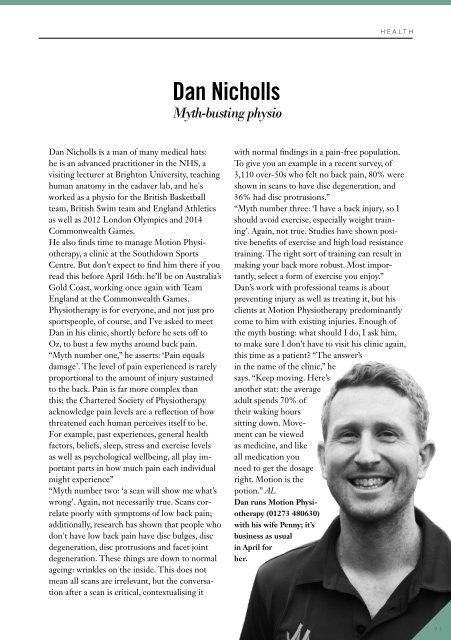You also want an ePaper? Increase the reach of your titles
YUMPU automatically turns print PDFs into web optimized ePapers that Google loves.
HEALTH<br />
Dan Nicholls<br />
Myth-busting physio<br />
Dan Nicholls is a man of many medical hats:<br />
he is an advanced practitioner in the NHS, a<br />
visiting lecturer at Brighton University, teaching<br />
human anatomy in the cadaver lab, and he's<br />
worked as a physio for the British Basketball<br />
team, British Swim team and England Athletics<br />
as well as 2012 London Olympics and 2014<br />
Commonwealth Games.<br />
He also finds time to manage Motion Physiotherapy,<br />
a clinic at the Southdown Sports<br />
Centre. But don’t expect to find him there if you<br />
read this before <strong>April</strong> 16th: he’ll be on Australia’s<br />
Gold Coast, working once again with Team<br />
England at the Commonwealth Games.<br />
Physiotherapy is for everyone, and not just pro<br />
sportspeople, of course, and I’ve asked to meet<br />
Dan in his clinic, shortly before he sets off to<br />
Oz, to bust a few myths around back pain.<br />
“Myth number one,” he asserts: ‘Pain equals<br />
damage’. The level of pain experienced is rarely<br />
proportional to the amount of injury sustained<br />
to the back. Pain is far more complex than<br />
this; the Chartered Society of Physiotherapy<br />
acknowledge pain levels are a reflection of how<br />
threatened each human perceives itself to be.<br />
For example, past experiences, general health<br />
factors, beliefs, sleep, stress and exercise levels<br />
as well as psychological wellbeing, all play important<br />
parts in how much pain each individual<br />
might experience”<br />
“Myth number two: ‘a scan will show me what’s<br />
wrong’. Again, not necessarily true. Scans correlate<br />
poorly with symptoms of low back pain;<br />
additionally, research has shown that people who<br />
don't have low back pain have disc bulges, disc<br />
degeneration, disc protrusions and facet joint<br />
degeneration. These things are down to normal<br />
ageing: wrinkles on the inside. This does not<br />
mean all scans are irrelevant, but the conversation<br />
after a scan is critical, contextualising it<br />
with normal findings in a pain-free population.<br />
To give you an example in a recent survey, of<br />
3,110 over-50s who felt no back pain, 80% were<br />
shown in scans to have disc degeneration, and<br />
36% had disc protrusions.”<br />
“Myth number three: ‘I have a back injury, so I<br />
should avoid exercise, especially weight training’.<br />
Again, not true. Studies have shown positive<br />
benefits of exercise and high load resistance<br />
training. The right sort of training can result in<br />
making your back more robust. Most importantly,<br />
select a form of exercise you enjoy.”<br />
Dan’s work with professional teams is about<br />
preventing injury as well as treating it, but his<br />
clients at Motion Physiotherapy predominantly<br />
come to him with existing injuries. Enough of<br />
the myth busting: what should I do, I ask him,<br />
to make sure I don’t have to visit his clinic again,<br />
this time as a patient? “The answer’s<br />
in the name of the clinic,” he<br />
says. “Keep moving. Here’s<br />
another stat: the average<br />
adult spends 70% of<br />
their waking hours<br />
sitting down. Movement<br />
can be viewed<br />
as medicine, and like<br />
all medication you<br />
need to get the dosage<br />
right. Motion is the<br />
potion.” AL<br />
Dan runs Motion Physiotherapy<br />
(01273 480630)<br />
with his wife Penny; it’s<br />
business as usual<br />
in <strong>April</strong> for<br />
her.<br />
91


















